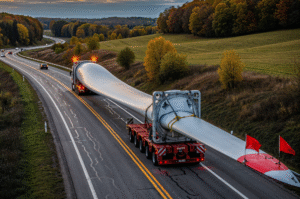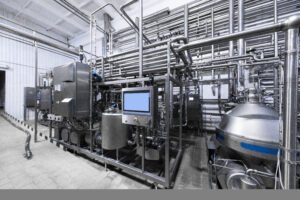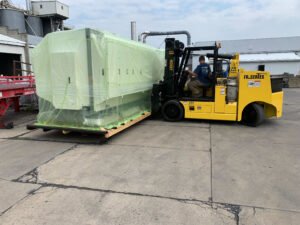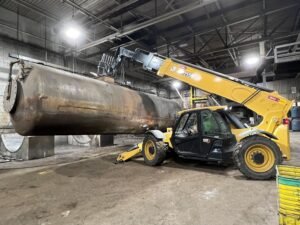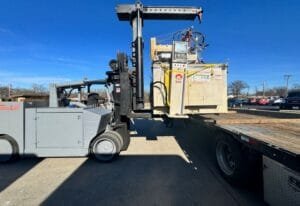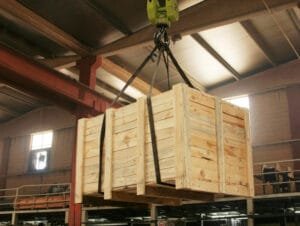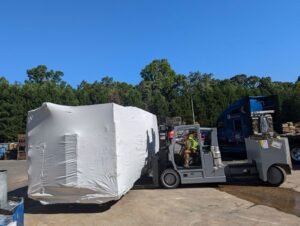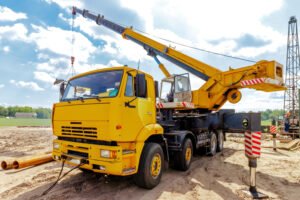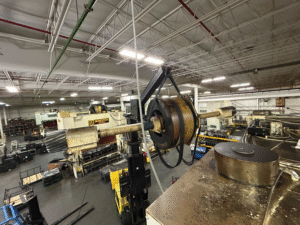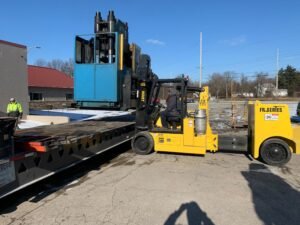Relocating heavy equipment is one of the most complex and high-risk tasks in industrial operations. Whether it’s a short-distance plant transfer or a cross-state move of large-scale machines, the process involves meticulous planning, safety coordination, permits, engineering logistics, and a strict adherence to timeline milestones. If not executed properly, the relocation can result in delays, increased costs, and serious damage to equipment or property. This guide explores the complete timeline of relocating heavy equipment and everything you need to know for a smooth, safe, and cost-effective move.
Understanding the Scope of Heavy Equipment Relocation
Defining Heavy Equipment Moves
Heavy equipment includes oversized, high-value machinery like CNC machines, stamping presses, generators, injection molding machines, turbines, transformers, and other immovable industrial assets. These machines are typically integrated deeply into plant infrastructure, making disassembly and transport challenging. The scope of relocation ranges from single equipment units to entire production lines or facilities.
Why Timeline Matters in Relocation
The timeline of heavy equipment relocation is not just a schedule—it’s the operational backbone of the move. Every phase must align precisely to ensure minimal disruption to production and business continuity. Missing one phase can have cascading effects, including missed regulatory inspections, expired permits, or delayed restart of operations at the destination site.
Project Stakeholders and Planning
From project managers, mechanical engineers, and rigging contractors to safety officers, logistics firms, and facility owners, the number of stakeholders in a relocation project is vast. A defined communication protocol and collaborative project management framework must be established early on to manage these moving parts effectively.
Pre-Relocation Phase – Planning and Preparation
Site Surveys and Risk Assessments
Before any move is executed, detailed site assessments are conducted both at the origin and destination. This includes examining:
-
Equipment footprint and anchoring
-
Floor load-bearing capacity
-
Utility disconnections
-
Clearance for rigging and hoisting
-
Transportation routes within the facility
Risk assessments are also crucial to determine potential safety, operational, and structural hazards during the move.
Timeline Development and Milestone Planning
Creating a Gantt chart or a digital project timeline helps identify critical dependencies and potential bottlenecks. Typical pre-move milestones include:
-
Finalization of scope and drawings
-
Procurement of rigging equipment
-
Schedule approvals from management
-
Coordination with utility providers for shutdowns
Each of these steps could take days to weeks, depending on the scale of the operation.
Regulatory and Legal Considerations
Compliance with local, state, and federal laws is non-negotiable. You may need:
-
Oversize/overweight transportation permits
-
Temporary road usage or escort permissions
-
Environmental and safety clearances
-
Utility disconnection authorization
-
Insurance documentation
Starting permit applications early helps align legal processes with the physical move timeline.
Dismantling, Rigging, and Packaging
Equipment Shutdown and Disconnection
The first physical step in relocation is the safe and controlled shutdown of the machine. This involves purging materials, relieving system pressure, and disconnecting utilities like water, electricity, air, and gas. Proper lockout/tagout procedures are mandatory during this phase.
Disassembly and Rigging Strategy
Rigging teams with experience in industrial environments develop a customized disassembly plan. Machines are broken down into manageable, weight-balanced segments. Structural integrity is preserved by using lifting points, load equalization, and anti-tip procedures. Labeling, photo documentation, and component inventory are recorded at every step.
Packaging for Transport Safety
All disassembled components must be packaged for vibration resistance, impact protection, and environmental insulation. Depending on the equipment, this may include custom crates, shrink wrap, vapor corrosion inhibitors, or bolted skid mounts. Sensitive electronics may need anti-static packaging or climate control enclosures.
Timeline Considerations for Dismantling
This phase typically takes 2–10 days depending on equipment complexity. For example, a large stamping press may take a full week just for safe dismantling, while a medium-size CNC machine may be ready in 1–2 days.
Transportation and Logistics Management
Choosing the Right Transportation Method
Not all transportation is created equal. Based on dimensions, weight, and route constraints, the relocation may involve:
-
Flatbed or lowboy trailers
-
Multi-axle heavy haul vehicles
-
Air ride suspension for shock absorption
-
Barge or rail movement for long-distance bulk transfers
The choice depends on access, cost, and safety of the route.
Permits and Route Planning
Route planning involves coordination with authorities for:
-
Over-dimensional load clearances
-
Road closures or police escorts
-
Bridge and overpass weight limits
-
Night travel restrictions
-
Highway usage fees
These need to be mapped well in advance, with buffer days factored into the timeline in case of delays.
Loading and Securing Equipment
Loading is done with cranes, forklifts, or gantries, depending on the weight class. Securement involves:
-
Chains and tie-downs rated for the load
-
Blocking and bracing to prevent shift
-
Load weight balance on axles
-
Vibration dampening for delicate systems
Each piece must pass a transport readiness inspection before departure.
Typical Timeframe for Transport
For intra-state or city-level moves, transportation may be completed in 1–3 days. Cross-country relocations or multi-equipment convoys may require 1–2 weeks or more, especially if traveling through permit-restricted regions.
Receiving, Reinstallation, and Commissioning
Offloading and Inspection
Upon arrival, receiving teams conduct visual and checklist-based inspections to ensure no damage occurred in transit. Damage reports and insurance claims must be filed immediately if needed. The equipment is offloaded in the exact layout configuration planned earlier.
Reassembly and Alignment
Reassembly must be done using the same technical documentation and photos collected during dismantling. Precision alignment using laser leveling, dial indicators, or precision jacks ensures machines are set to operational tolerances. Mechanical, hydraulic, and electrical connections are re-established.
Calibration and Testing
Each machine must be:
-
Calibrated for accuracy
-
Lubricated and pre-run for warm-up cycles
-
Subjected to functional testing under no-load and partial-load conditions
-
Inspected for sensor calibration, noise, heat, and vibration
Testing can take 2–5 days per unit depending on the type of equipment.
Safety Certification and Handover
Once operational, safety audits are conducted by in-house or third-party specialists. Certificates of readiness, re-inspection logs, and compliance approvals are obtained. The equipment is then handed over to the production team, and operational documentation is updated.
Post-Move Considerations and Optimization
Timeline Buffers and Contingency Planning
Even the best-planned relocations face unexpected delays—weather, permit issues, mechanical hiccups, or labor shortages. A smart timeline incorporates contingency buffers of 10–20% for each phase to absorb such risks without disrupting go-live dates.
Lessons Learned and Documentation
After completion, a formal review is critical. Capture:
-
What went right
-
What caused delays
-
Improvement areas for future moves
This forms part of your company’s relocation playbook and improves efficiency for future projects.
Optimizing Equipment Performance After Move
Once installed, equipment should be monitored for the first 30–60 days with KPIs like:
-
Uptime percentage
-
Defect rate
-
Maintenance alerts
-
Energy consumption
This helps ensure the equipment is performing as expected in the new location and that relocation has not impacted long-term reliability.
Alltracon: Your Trusted Partner in Heavy Equipment Relocation
When precision, safety, and efficiency matter most, Alltracon is the partner industries trust for seamless heavy equipment relocation. With decades of experience in rigging, millwright services, and turnkey plant moves, Alltracon ensures every relocation project is handled with unmatched professionalism, reducing downtime and maximizing operational success.
Final Thoughts
The timeline for relocating heavy equipment is a multifaceted, high-stakes process that demands strategic planning and flawless execution. Each phase—from pre-planning and permits to rigging, transport, and reinstallation—has unique requirements and risks. By following a disciplined timeline, integrating contingency buffers, and working with experienced partners like Alltracon, companies can ensure a smooth transition with minimal disruption and long-term operational gains.
Properly executed, a heavy equipment relocation isn’t just a necessary task—it’s an opportunity to upgrade efficiency, reduce waste, and prepare for future growth.

